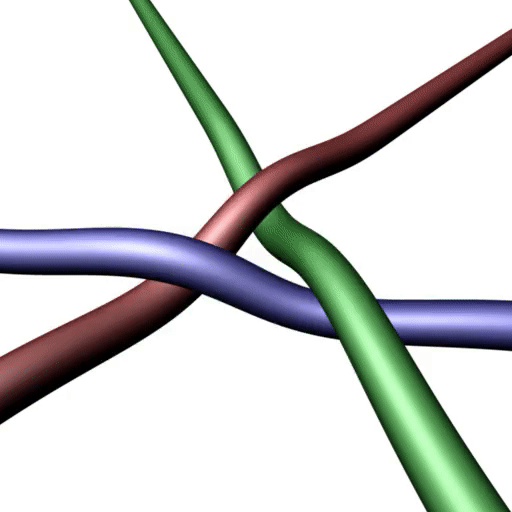I believe we are nearing an impasse. I have repeatedly asked for clear definitions and equations, but your answers continue to be vague and leaves your theory a black box with an oracle, we must turn to you to put anything into the theory and turn to you to interpret anything coming out of the theory. This leaves it not a theory at all.
Let's start at the foundations.
It is trivial to see that all three of those tangles can be made to look locally the same, and then straight segments going off to infinity. Indeed you admitted the difference between the electron and W is "at spatial infinity".
My point though is that all THREE can be made to look locally the same where the "tangle" is localized, and then straight segments going off to infinity.
This causes two problems:
1) we cannot locally determine if something has charge
2) we cannot locally determine if something is a fermion or boson
You may call something an electron, but its strands curve differently off beyond our galaxy, making it actually a boson, or a neutrino.
If you feel we are misunderstanding. Again, I implore you, provide your meaning clearly in math so that _anyone_ can play with your ideas and test out predictions themselves.
Let us try to elevate this discussion to the precision of math.
Can we describe your setup in the following way?
We start with a flat unobservable background spacetime. For some finite spherical region of space, but "macroscopic" (i.e. R >> Planck scale) there are N strands which we can define with parametric equations, strand_i : (s,t) -> (x,y,z). Where i indexes/labels the strands 1 to N, the variable s is some parameterization along the strand (say length), and t,x,y,z are coordinates in the background space-time. It is a requirement of your theory that each strand_i terminates on the spherical surface.
A rough overview as I understand it.
Your belief is that given such a configuration at time t_0,
1) you can describe the particle content at that time
2) you can point out all the crossings
and that moving forward in time
3) the motion of the strands is stochastic (besides "do not cross each other", these details appear unknown)
4) you can point out all the crossing switches
5) only these switches are observable
-- even larger leap you seem to not acknowledge --
without even knowing how to describe the motion of the strands, you claim you can derive how these strand motions lead to the following
6) somehow the observable switches give rise to a derived space-time which is observable
7) somehow all the of GR is derived
8) somehow all of standard model is derived
It is too much to do all at once, so let's focus on #1 first, so no need to discuss kinematics at the moment.
You state confidently that you have systematically characterized all possible particles. But there are plenty of more tangles possible. So can you describe _mathematically_ how your characterization works? For instance, why are you confident that there are no particles with 237 strands cores?
Let's break this down even further:
If I give you all the parameterized strand_i for some time t, can you describe _mathematically_ how to calculate the charge in this volume?
Since your particle assignment seems to need no more than three strands, is it possible to break this up into:
total charge Q = sum_{all possible choices of three strands, i<j<k} charge_of(strand_i, strand_j, strand_k)
that is
Q = sum q_ijk
where q_ijk is the charge assigned to the configurations of the strands i,j,k ?
Is so, then you only need to state how to calculate q_ijk.
If you can provide this, it would be the first step in making your particle assignments rigorous.
cschiller said:
The left one (electron neutrino) is almost massless: it is localized, but a straight strand can be "pulled away". The tangle is chiral, but not topologically chiral.
This is exactly why you need to start responding in math instead of making up new terms you do not clearly define.
A) It is not clear what is meant by "a strand can be pulled away", as the three diagrams are so similar any interpretation of this appears to be true for the others.
B) It is unclear what you mean by "chiral, but not
topologically chiral".
If how "localized" the tangle is affects its mass, it is unclear how any of those tangles are more localized than the others ... and definitely not orders or magnitude more "localized".
It appears what you are saying doesn't fit together.
cschiller said:
The right one (W) ... It has spin 1, because you can put rotate its core (curved region, just one strand needs to be rotated) by pi and return to the original tangle. This is not possible with the previous 2 tangles.
This makes no sense. Why do you demand the whole core (all three strands) rotate for the others, but here suddenly only require rotating one of the stands.
If I rotate the diagram 2pi, I will need to rotate another 2pi before the belt trick can be used.
cschiller said:
If the strands are straight in your Mathematica drawing, it is an electron neutrino or antineutrino, depending on chirality.
Yes, those strands are straight.
And now I KNOW you are completely making it up as you go.
Because those three strands are three from what you previously called vacuum.
Your definition of a particle is so vague it is completely unclear to me how you can have a vacuum.
What you previously called empty, you are now claiming is actually filled with neutrinos.
If this doesn't make it clear to you why you need to be more systematic and precise in your definitions, I'm not sure what will.
